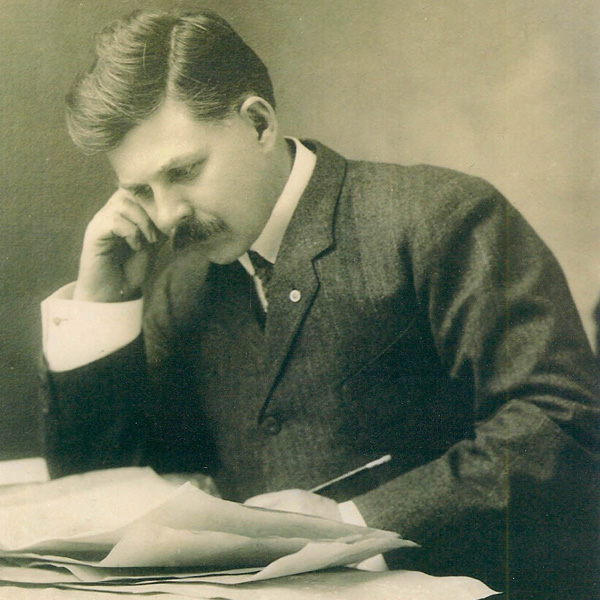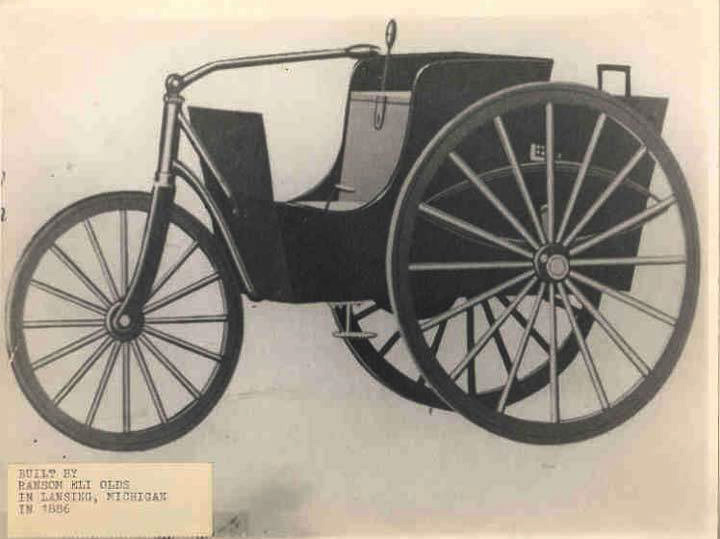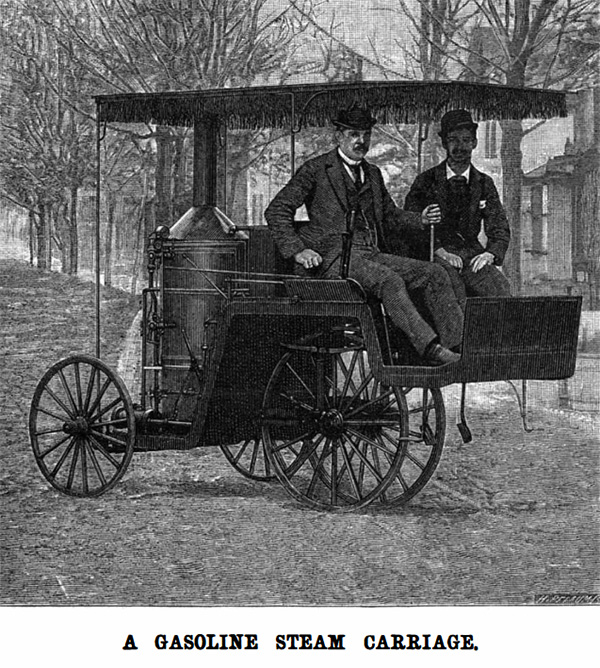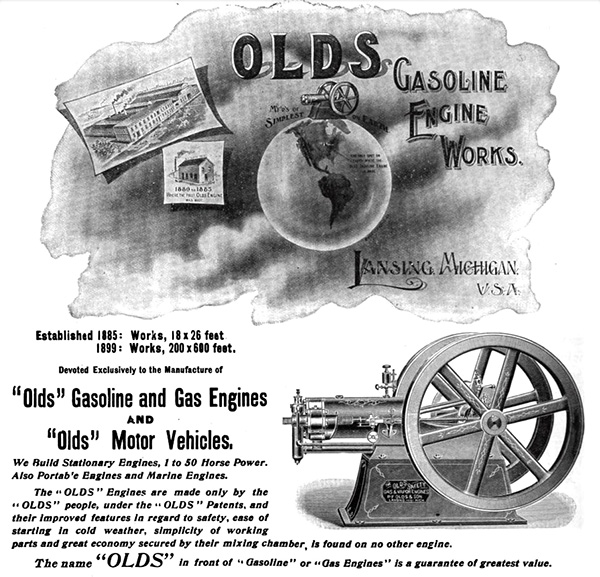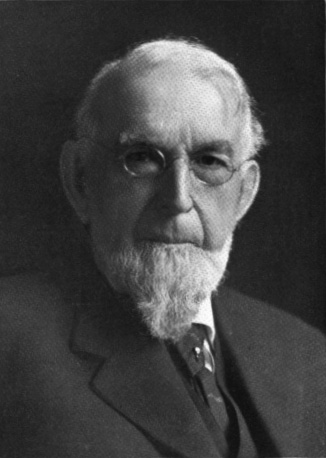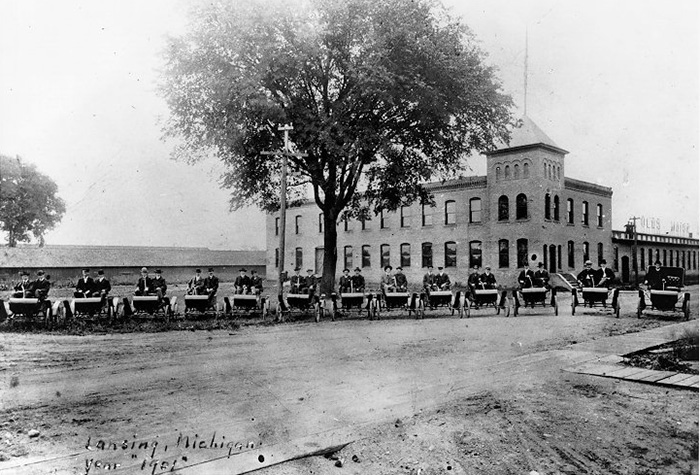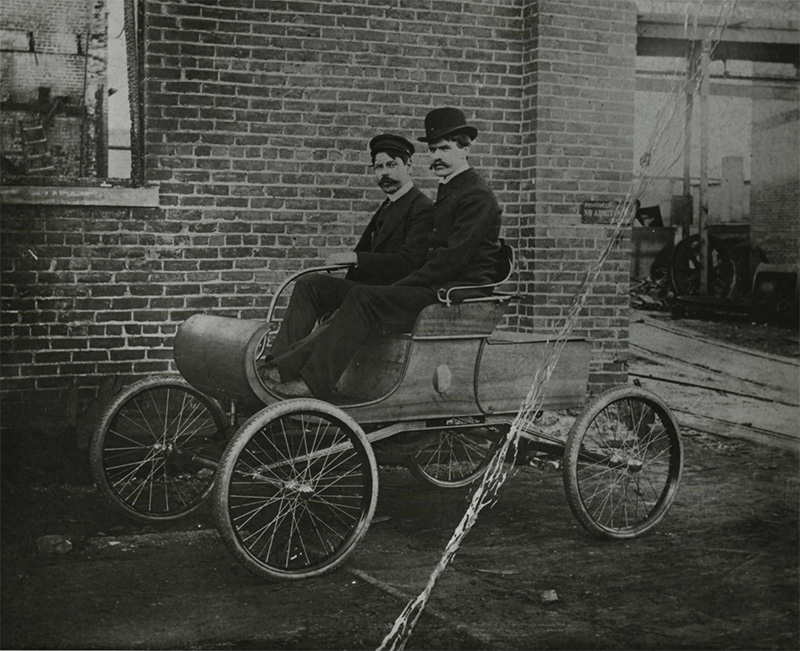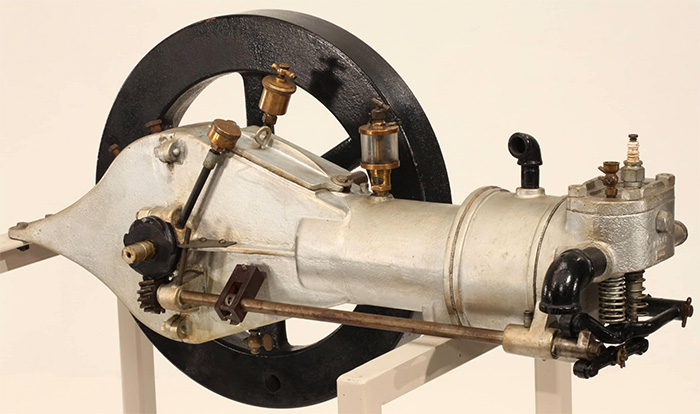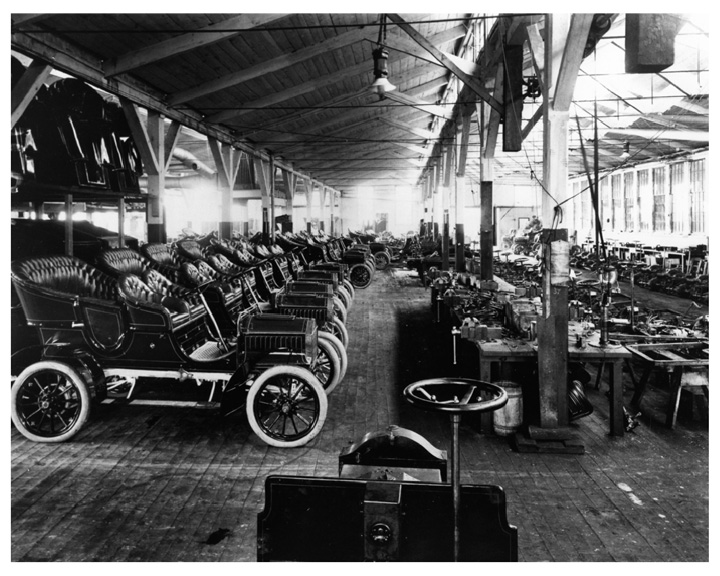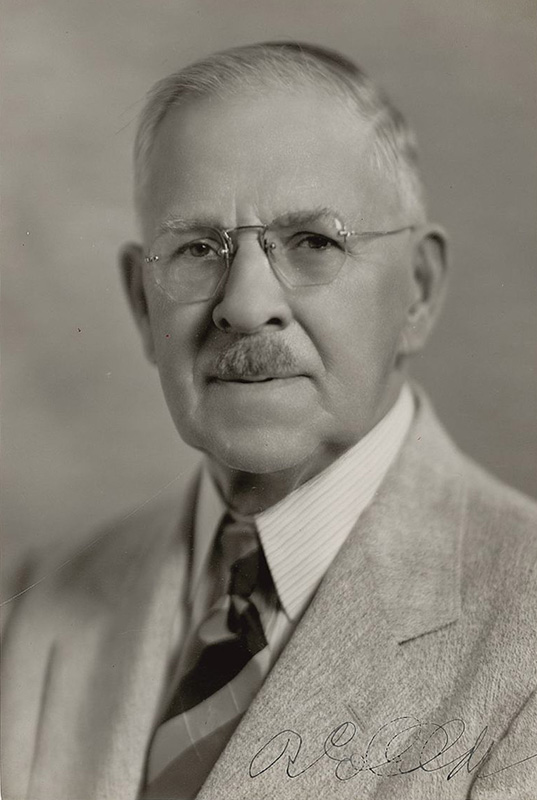The Oldsmobile is the Best Thing on Wheels, for there is nothing to watch but the road...
Born in Geneva, Ohio in 1864 and raised in Lansing, Michigan, Ransom Eli Olds spent his early years building a variety of experimental engines and vehicles as the son of a blacksmith. He learned his fathers ways — diligence and exacting work — at an early age. He insisted upon high quality components and for a number of years, limited car production versus selling a car that could not hold up to his standards. Olds wanted to bring the city and farm folks into each other’s world. At the closing of the 1800s, Ransom got to tinkering with steam-powered cars, he claimed to have built his first steam-powered car in 1884. In 1885, Ransom Olds became a partner in his father's machine shop firm, which became a leading manufacturer of gas-heated steam engines. In 1886, he received his first patent for a gasoline-powered car. In 1895 Ransom and his father opened Olds Gasoline Engine Works where the two experimented and worked- and by 1896 had built their first gasoline-powered automobile. He even went so far as to go racing with the terrifying creation above dubbed the "Olds Pirate."
Ransom Eli Olds in the late 1800's
In 1897 Ransom Olds founded the Olds Motor Vehicle Company, replacing his father’s shop and the Olds Gasoline Engine Works. That year, he sold a grand total of four cars. The vehicle company sputtered, but the engine company succeeded. The cars didn't sell very well on account of expense and the general populations aversion to being early-adopters. By 1899 an investor by the name of Samuel L. Smith stepped in and bought the company, putting Ransom in charge of operations. That year, Olds reorganized in Detroit and formed the Olds Motor Works. The company secured five acres of land at 1330 Jefferson Ave., near the Belle Isle Bridge along the Detroit River to build a new factory. It was the first designed specifically for manufacturing automobiles. The plant began operations in March of 1900 and Olds had built a total of 11 prototype vehicles by the start of 1901, including at least one example of a steam, electric and gasoline-powered vehicles. Among these pilot/prototype cars, was a small, light horseless carriage with a single-cylinder, water-cooled four-cycle engine at the rear. Its most distinctive feature was its curved dashboard. The small Curved Dash Olds was a favorite in the plant, but it was not really known to the public and was not much of a factor in the company's sales. It was considered a "mascot" or a "toy." Olds Motor Vehicle Company & Olds Motor Works
On March 1, 1901, a fire broke out at the Olds factory and burned the facility to the ground. Olds had just returned from a vacation to find his factory in smoldering ruin and most of his prototype vehicles destroyed. However, one vehicle was saved from the fire; the gas-powered “Curved Dash” runabout. The plans for the vehicle had also survived the fire, as had the foundry. Though Olds had built other prototype vehicles, it was decided to rebuild immediately and put all of the firm's production resources into the little Curved Dash Olds. He began producing it later in the year and not only radically reduced the price of the car but made interchangeable parts the order of the day. This was a momentous decision because, it committed Olds to production of a small, relatively inexpensive car, its first "high-volume" model. Proving the adage that "it's an ill wind that blows no good" (few things are so bad that no one profits from them), the fire had a positive effect -- news of the fire made thousands of people aware of the car. Inquiries and orders began arriving, some accompanied by cash payments. While other carmakers concentrated on large, high-priced automobiles, Ransom Eli Olds introduced his simple little Curved Dash Oldsmobile in 1901 and sold it for a relatively inexpensive $650. Olds was among the first to realize the potential in an affordable automobile for the masses, and his Curved Dash runabout put car ownership within the means of the middle class. A single-cylinder, four horsepower engine powered the Oldsmobile Curved-Dash runabout. It had one cylinder, one piston, one connecting rod and crank, one balance wheel, and two valves. The complications of larger multi-cylinder engines were eliminated. The engine's simplicity and the vehicle's affordable $650 price made the Curved-Dash runabout America's first car produced in large numbers.
1901 Factory Fire & The Curved Dash Olds
Incidentally, the factory fire also led Olds to create the first system of automotive suppliers. In late 1900, to keep up with demand, Olds contracted with the Dodge Brothers for engines and Henry M. Leland, head of Leland and Faulconer Co., for transmissions. These were some of the first large component orders made by an auto maker to outside suppliers. Olds continued contracts with Leland and Dodge in June 1901 to make thousands of engines and transmissions for the curved-dash Oldsmobile. When Ransom E. Olds turned down an improved engine design offered by Leland (Olds didn’t want to pause production on the Oldsmobile line long enough to re-tool for a new engine), Leland ceased upon the opportunity presented to him by the officers of the failing Henry Ford Company (formerly Detroit Automobile Company). Leland founded Cadillac in 1902 out of the ashes of the Henry Ford Company. Cadillac, named for Detroit founder Le Sieur Antoine de la Mothe Cadillac. When supply was outstripped by demand, Olds developed and patented the very first assembly line. Ransom put in place much of what we recognize as the assembly line today, defined repetitive operations, fixed stations and parts delivered to the worker. In 1902 the factory's output quadrupled from 425 cars in 1901 to 2,500. The credit for the invention of the assembly line often goes to Henry Ford because of one very critical addition, Ford put the cars on a conveyor of sorts, creating the all-important moving assembly line. Production of the Curved Dash increased exponentially in the ensuing years and by 1903, Olds Motor Works had become the largest automotive manufacturer in the United States. Oldsmobile made 30% of the cars built in the United States in 1903. By 1905 Olds had moved back to Lansing and was building 5,000 cars a year. Canadian production began in 1905 and was discontinued before the end of 1907 due to a change in market need - these cars were seen as too large and expensive for the Canadian market of the time. Oldsmobile’s Canadian operation became just a selling and servicing agency for imported vehicles, and headquarters were moved to Toronto. Oldsmobiles were not made again in Canada until 1920, when the newly founded General Motors of Canada began building them in Oshawa.
Automobile Suppliers & The Assembly Line
Olds Motor Works’ well-priced, reliable runabout was the bestselling car in America from 1902-1905. Despite its popularity, automobiles were not a significant player in the transportation world. In 1903, 4000 people bought Oldsmobiles, but more than 900,000 bought buggies and carriages. Many would-be customers balked at the high price of an automobile. Oldsmobile offered a popular counterargument in a 1903 advertisement. The car required $35 in gasoline for a year of operation, while a horse needed $180 in food. What's more, the car only used gas when it ran, while a horse had to be fed whether it worked or not. Carmakers sought customers beyond private owners. They saw lucrative potential in motorizing police departments, fire departments and other municipal agencies. This 1906 advertisement from Oldsmobile promotes the car's use by the Boston Fire Department. There is an implied message, too: If the Oldsmobile can handle rugged fire service, think how well it can serve your everyday needs. Olds also was the first to use publicity stunts to market his vehicles. To draw attention to his vehicles in those early days, Olds commissioned a young associate, Roy D. Chapin, to drive a Curved Dash Olds to New York for an appearance at the 1901 New York Auto Show. Chapin left Detroit on Tuesday, Oct. 29, 1901. He went 278 miles through Ontario to Niagara Falls, an amazing performance. On Friday he encountered heavy rains between Syracuse and Albany. The muddy roads were nearly impassable, so Chapin asked about driving on the level and well-finished roads along the Erie canal (used by mules to pull barges). He was told he would be jailed if he used it! Nonetheless, fifteen minutes later, he pulled the little Olds onto the all weather road that stretched along the canal to the horizon. On Manhattan's Fifth Avenue, only blocks from the Waldorf-Astoria, he swerved to avoid hitting a man who stepped in front of the Olds. The car hit the curb and deformed a wheel. Chapin bent it back as best he could and drove on. Roy Chapin, (who would later head the Hudson Motor Car Co. and whose son, Roy Jr., would head American Motors Corp.), had completed the longest automobile trip that had been made in this country up until that time. Ransom Olds was waiting in the lobby of the hotel to greet him, but Chapin -- covered with grease and dust -- was ordered by the doorman to use the service entrance at the rear of the hotel. In 1905, two Oldsmobiles competed in an east to west transcontinental race from New York City to Portland, Oregon. In the photograph Dwight B. Huss navigates "Old Scout" through Iowa's flooded Skunk River. Old Scout won the race over his competitor "Old Steady" reaching Portland in forty-four days. The Curved Dash runabout made Oldsmobile a success, but some customers wanted something more modern than the little runabout's decidedly carriage-inspired look. Oldsmobile's "French Front" touring model featured a long hood out front, just like sophisticated import automobiles. But the Olds hood was largely for show -- the one-cylinder engine still sat under the seat. (1905)
Promotion & Popularization
When early backer Samuel L Smith wanted to produce a more expensive car to serve the burgeoning luxury market, Olds quit and formed REO Motor Car Company in 1905. Again using publicity to attract attention to his vehicle, Olds arranged for a long distance automobile trip. The most famous REO episode was the 1912 Trans-Canada journey. Traveling 4,176 miles (6,720 km) from Halifax, Nova Scotia, to Vancouver, British Columbia, in a 1912 REO special touring car, mechanic/driver Fonce V. (Jack) Haney and journalist Thomas W. Wilby made the first trip by automobile across Canada. In 1915, Ransom Olds relinquished the title of general manager of REO Motor Car to his protégé Richard H. Scott and 8 years later he ended his tenure as the company's presidency as well, retaining the position of chairman of the board. In 1915, Ransom Olds formed the Ideal Power Lawn Mower Company to manufacture his newest invention, the gasoline-powered lawn mower. Ransom Olds would retire in 1925, having given Detroit’s signature industry a generous portion of innovations. In 1908 Oldsmobile was acquired by William Durant and became part of the new General Motors Durant was building. Oldsmobile was integrated into the General Motors empire and gradually emerged as an upscale sporty and experimental car. In the first years of the 20th century, the automotive industry was a mess. There were over 40 different car companies in the United States, most of which sold only a handful of cars each year, there was a tendency to take customers’ down payments and then go out of business before delivering. To build consumer confidence and drive the weak car companies out of business, consolidation of the largest and most reliable manufacturers into one big company was an idea that appealed to Billy Durant, who had made millions in the carriage business just that way: Instead of selling one kind of vehicle to one kind of customer, Durant’s company had sold carriages and carts of all kinds, from the basic to the luxurious. Ransom Olds Departure, REO & Acquisition by GM
Continue on to Oldsmobile History - 1908 to 1952


